By Leen Randell
Updated: Jul 04, 2024
10 Best Herbal Decoctions For Arthritis
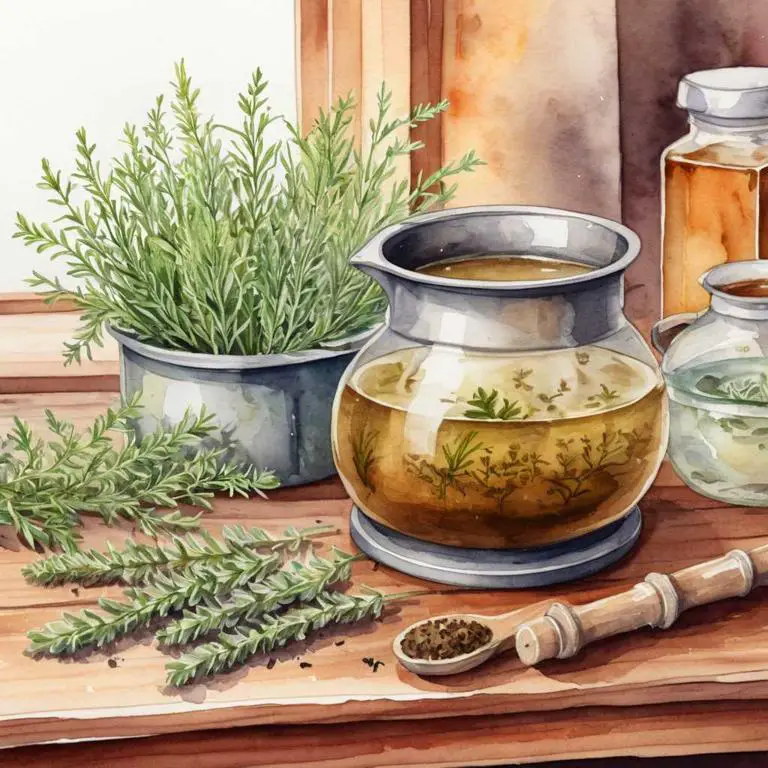
Herbal decoctions for arthritis are liquid extracts made by steeping herbs in hot water, which can provide relief from joint pain and inflammation.
These decoctions work by reducing swelling, stiffness, and discomfort associated with rheumatoid arthritis, osteoarthritis, and other forms of the condition. For example, turmeric decoction has anti-inflammatory properties that reduce joint pain and stiffness, while ginger decoction helps to reduce inflammation and improve joint mobility.
By incorporating these herbal remedies into their daily routine, individuals with arthritis can experience improved flexibility, reduced morning stiffness, and enhanced overall quality of life.
The following article describes in detail the most important decoctions for arthritis, including medicinal properties, parts of herbs to use, and recipes for preparations.
- 1. Capsicum annuum
- 2. Glycyrrhiza glabra
- 3. Curcuma longa
- 4. Urtica dioica
- 5. Rheum palmatum
- 6. Salix alba
- 7. Hypericum perforatum
- 8. Vaccinium macrocarpon
- 9. Lavandula angustifolia
- 10. Rosa rugosa
- What is the best combination of herbal decoctions to use for arthritis?
- What ailments similar to arthritis are treated with herbal decoctions?
1. Capsicum annuum
Bell pepper decoctions helps with arthritis because they are rich in antioxidants and anti-inflammatory compounds that help reduce joint pain and inflammation.
The decoction's flavonoids, carotenoids, and vitamin C work together to combat free radicals and ease the symptoms of arthritis, making it an effective natural remedy for managing the condition.
Additionally, bell pepper decoctions have been shown to improve flexibility and reduce stiffness in joints, leading to a significant improvement in overall quality of life for those suffering from arthritis.
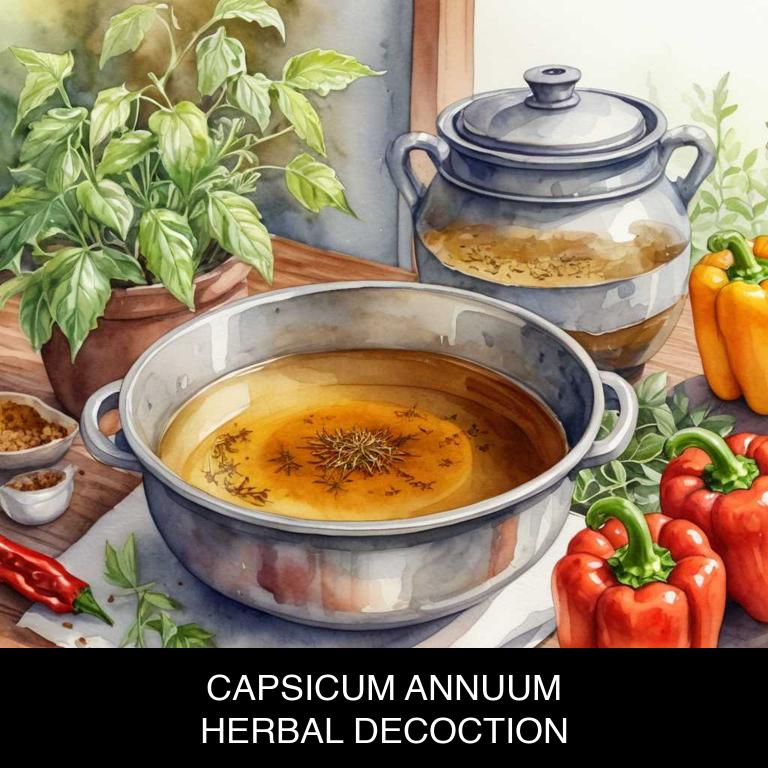
Medicinal Constituents
The list below shows the primary medicinal constituents in Capsicum annuum decoctions that help with arthritis.
- Capsaicinoids: Capsaicinoids, particularly capsaicin, help with arthritis by inhibiting the production of pro-inflammatory substances, such as prostaglandins and bradykinin, which contribute to joint pain and inflammation.
- Phenolic acids: Phenolic acids, including ferulic and caffeic acids, have potent anti-inflammatory and antioxidant properties that help reduce inflammation and oxidative stress associated with arthritis.
- Carotenoids: Carotenoids, including capsanthin and capsorubin, possess anti-inflammatory and antioxidant activities that help protect joints from oxidative damage and inflammation, thereby alleviating arthritis symptoms.
Parts Used
The list below shows the primary parts of bell pepper used to make decoctions for arthritis.
- Fruits: Capsaicin, a compound found in the fruits, is used to reduce pain and inflammation in people with arthritis.
- Leaves: The leaves contain capsaicin and other bioactive compounds that have anti-inflammatory and pain-relieving properties.
- Seeds: The seeds of Capsicum annuum are also a source of capsaicin and other compounds that help alleviate arthritis symptoms.
Quick Recipe
The following recipe gives a procedure to make a basic bell pepper for arthritis.
- Gather fresh capsicum annuum fruit weighing 30g for decoction.
- Cut the capsicum annuum into small pieces to increase their surface area for extraction.
- Boil 1 liter of water and add the capsicum annuum pieces for 10 minutes.
- Reduce heat and simmer the mixture for 20 minutes to enhance extraction.
- Strain the decoction using a cheesecloth or fine mesh and discard the solids.
2. Glycyrrhiza glabra
Licorice decoctions helps with arthritis because they contain anti-inflammatory compounds that reduce joint swelling and pain.
The decoction's glycyrrhizin and flavonoids work together to suppress inflammation, alleviate stiffness, and improve mobility. Additionally, licorice root has been shown to inhibit the production of pro-inflammatory enzymes, further reducing joint damage and discomfort.
By incorporating licorice decoctions into one's treatment plan, individuals with arthritis can experience a significant improvement in their symptoms and overall quality of life.

Medicinal Constituents
The list below shows the primary medicinal constituents in Glycyrrhiza glabra decoctions that help with arthritis.
- Glycyrrhizin: A triterpenoid saponin that helps with arthritis by reducing inflammation and suppressing the production of pro-inflammatory enzymes.
- Liquiritin: A phenolic compound that helps with arthritis by inhibiting the production of pro-inflammatory cytokines and enzymes, thereby reducing joint inflammation and pain.
- Licoricidin: A flavonoid that helps with arthritis by reducing oxidative stress and inflammation, and also by inhibiting the production of pro-inflammatory enzymes and cytokines.
Parts Used
The list below shows the primary parts of licorice used to make decoctions for arthritis.
- Roots: The roots are the primary source of glycyrrhizin, a compound with anti-inflammatory properties that helps alleviate arthritis symptoms.
- Leaves: The leaves contain flavonoids and phenolic acids, which have antioxidant and anti-inflammatory effects that help reduce arthritis pain and inflammation.
- Barks: The barks contain flavonoids and glycosides, which have anti-inflammatory and immunomodulatory effects that help alleviate arthritis symptoms and promote healing.
Quick Recipe
The following recipe gives a procedure to make a basic licorice for arthritis.
- Harvest 250 grams of dried glycyrrhiza glabra roots from a reputable source and clean them thoroughly.
- Grind the roots into a fine powder using a mortar and pestle to facilitate extraction.
- Combine the powdered roots with 1000 milliliters of boiling water in a saucepan and reduce heat.
- Simmer the mixture for 20 to 30 minutes or until the liquid has reduced to 200 milliliters.
- Strain the decoction through a cheesecloth or a fine-mesh sieve into a clean container.
3. Curcuma longa
Turmeric decoctions helps with arthritis because of its potent anti-inflammatory properties, which reduce joint swelling and pain.
Curcumin, a compound found in turmeric, inhibits pro-inflammatory enzymes and cytokines, thereby alleviating symptoms of osteoarthritis. Additionally, the decoction's antioxidant properties help to neutralize free radicals, preventing further damage to joints and surrounding tissues.
Regular consumption of turmeric decoctions has been shown to improve joint mobility, reduce stiffness, and enhance overall quality of life for individuals suffering from arthritis.
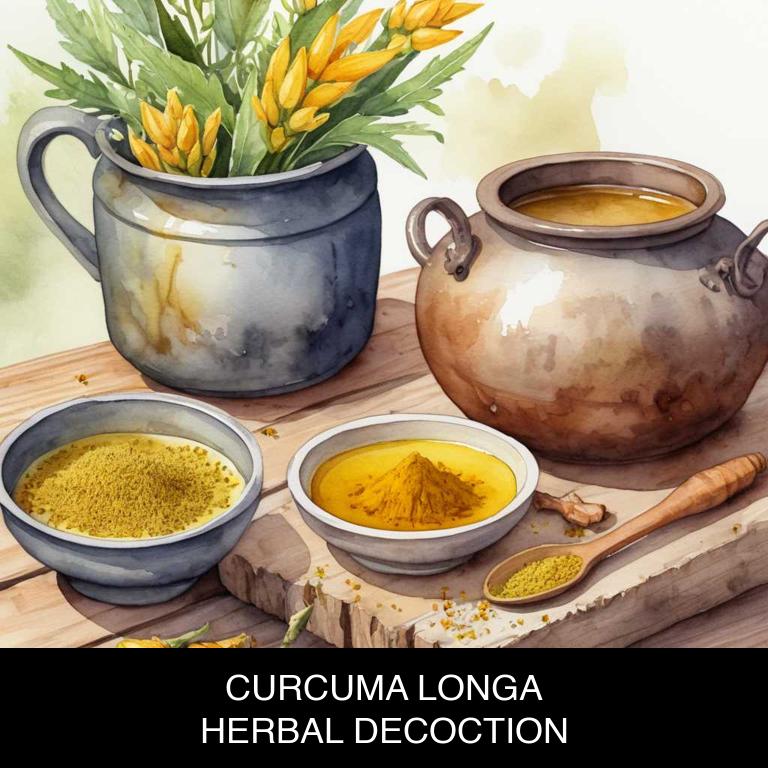
Medicinal Constituents
The list below shows the primary medicinal constituents in Curcuma longa decoctions that help with arthritis.
- Curcumin: Curcumin is a polyphenolic compound that has potent anti-inflammatory and antioxidant properties, which help to reduce joint inflammation and alleviate arthritis symptoms.
- Demethoxycurcumin: DMC is a curcuminoid that has shown to inhibit the production of pro-inflammatory enzymes, such as COX-2 and LOX, which contribute to joint pain and inflammation in arthritis.
- Bisdemethoxycurcumin: BDMC is a curcuminoid that has been found to have potent anti-inflammatory and antioxidant effects, which help to reduce oxidative stress and inflammation in the joints, leading to relief from arthritis symptoms.
Parts Used
The list below shows the primary parts of turmeric used to make decoctions for arthritis.
- Roots: The roots of Curcuma longa contain a high amount of curcuminoids, which make them effective in reducing inflammation and pain associated with arthritis.
- (optional) stems: Some studies suggest that the stems of Curcuma longa may also contain curcuminoids, although they are not as widely used as the rhizomes or roots.
Quick Recipe
The following recipe gives a procedure to make a basic turmeric for arthritis.
- Harvest the fresh root of curcuma longa by digging up mature plants when the turmeric rhizomes are firm.
- Dry the harvested root in a well-ventilated area under shade for 7-10 days to reduce moisture content.
- Grind the dried root into a fine powder using a spice grinder or mortar and pestle.
- Measure out 1-2 teaspoons of the turmeric powder and boil it in 1 liter of water for 5-10 minutes.
- Strain the decoction through a cheesecloth or fine mesh to remove any remaining particles before serving.
4. Urtica dioica
Stinging nettle decoctions helps with arthritis because of its anti-inflammatory properties, which help reduce joint pain and swelling.
The decoction's ability to block the production of certain chemicals that cause inflammation also contributes to its effectiveness. Additionally, stinging nettle is rich in antioxidants, which help protect against cell damage caused by free radicals.
By reducing inflammation and oxidative stress, stinging nettle decoctions can provide relief from arthritis symptoms, improving joint mobility and overall quality of life for individuals suffering from this chronic condition.

Medicinal Constituents
The list below shows the primary medicinal constituents in Urtica dioica decoctions that help with arthritis.
- Flavonoids: These plant-based compounds, particularly quercetin, found in Urtica dioica decoctions help with arthritis by reducing inflammation and oxidative stress, which contribute to joint pain and swelling.
- Furanocoumarins: These compounds, including diosmin and imperatorin, have anti-inflammatory and immunomodulatory effects, which can help alleviate the symptoms of arthritis, such as joint pain and stiffness.
- Polysaccharides: The polysaccharides present in Urtica dioica decoctions, particularly inulin and arabinose, have been shown to exhibit anti-inflammatory and antioxidant activities, which may contribute to the herb's potential benefits in managing arthritis symptoms.
Parts Used
The list below shows the primary parts of stinging nettle used to make decoctions for arthritis.
- Leaves: Rich in anti-inflammatory compounds, particularly histamine and 5-hydroxytryptamine, which help reduce pain and inflammation.
- Stems: Contain bioactive compounds like flavonoids and phenolic acids, which contribute to their anti-inflammatory and antioxidant properties.
- Roots: Used for their rich content of iridoid glycosides, which are known for their anti-inflammatory and immunomodulatory effects.
Quick Recipe
The following recipe gives a procedure to make a basic stinging nettle for arthritis.
- Harvest fresh urtica dioica leaves and stems in the early morning or evening when moisture content is higher.
- Chop the harvested urtica dioica material into small pieces with a sharp knife or kitchen shears.
- Combine 20-30 grams of chopped urtica dioica with 1 liter of boiling water in a heat-resistant container.
- Steep the mixture for 5-10 minutes in a covered container to allow the active compounds to infuse.
- Strain the decoction through a cheesecloth or a fine-mesh sieve into a clean container to discard solids.
5. Rheum palmatum
Chinese rhubarb decoctions helps with arthritis because it has been traditionally used to relieve pain and inflammation associated with rheumatoid arthritis, osteoarthritis, and other musculoskeletal conditions.
The decoction's active compounds, such as rhein and emodin, have anti-inflammatory and analgesic properties that help reduce swelling and alleviate joint discomfort.
Additionally, rhubarb's ability to improve blood circulation and relax muscle tissue can further enhance its therapeutic effects in managing arthritis symptoms.
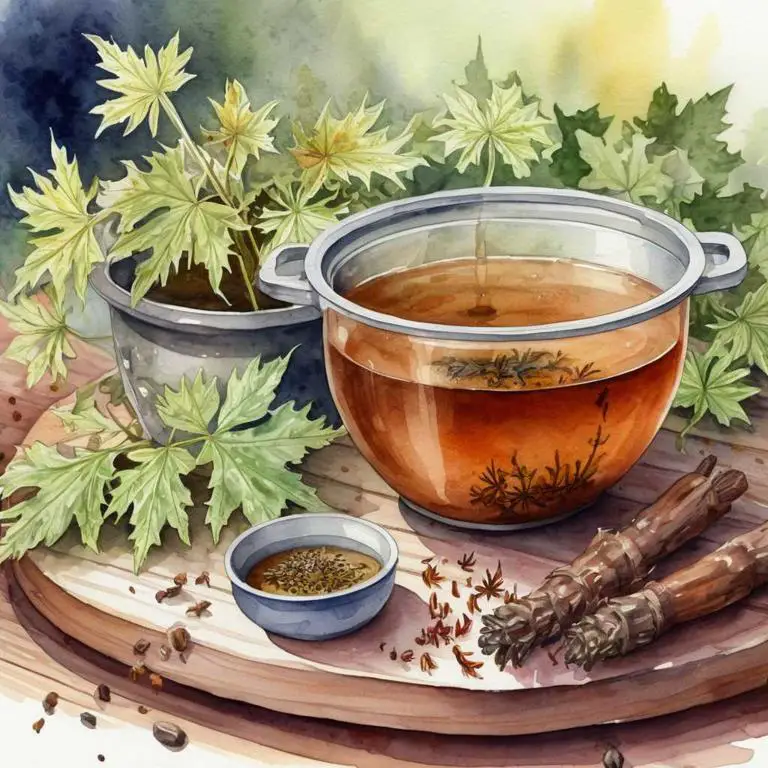
Medicinal Constituents
The list below shows the primary medicinal constituents in Rheum palmatum decoctions that help with arthritis.
- Anthraquinones: These compounds have anti-inflammatory properties, which help in reducing joint pain and swelling associated with arthritis.
- Saponins: These natural compounds have anti-arthritic properties, which help in reducing inflammation and preventing the progression of joint damage.
- Flavonoids: These plant compounds have antioxidant and anti-inflammatory effects, which help in reducing oxidative stress and inflammation in the joints, thereby alleviating arthritis symptoms.
Parts Used
The list below shows the primary parts of chinese rhubarb used to make decoctions for arthritis.
- Roots: The roots contain high levels of anthraquinones, which have anti-inflammatory properties to help alleviate arthritis symptoms.
- Rhyzomes: Rhyzomes have a higher concentration of anthraquinones and saponins, making them effective in reducing pain and inflammation associated with arthritis.
- Leaves: The leaves are a rich source of flavonoids, which have antioxidant properties that help to reduce inflammation and promote healing in joints affected by arthritis.
Quick Recipe
The following recipe gives a procedure to make a basic chinese rhubarb for arthritis.
- Gather 30-60 grams of dried rheum palmatum root, clean and sifted.
- Weigh the dried rheum palmatum root and measure 4-6 cups of water.
- Combine the dried rheum palmatum root and water in a saucepan, then heat over medium.
- Simmer the mixture for 10-15 minutes, occasionally stirring, until the liquid has reduced slightly.
- Strain the decoction through a cheesecloth or fine-mesh sieve into a clean container.
6. Salix alba
White willow decoctions helps with arthritis because of its unique combination of compounds, particularly salicin, a natural analogue of aspirin.
This anti-inflammatory compound works by reducing swelling and pain in the affected joints, providing relief from symptoms associated with osteoarthritis and rheumatoid arthritis. As the decoction is absorbed into the bloodstream, it targets specific areas of inflammation, allowing for targeted pain relief without affecting other parts of the body.
This natural approach can help alleviate stiffness, aches, and discomfort, promoting improved mobility and quality of life.
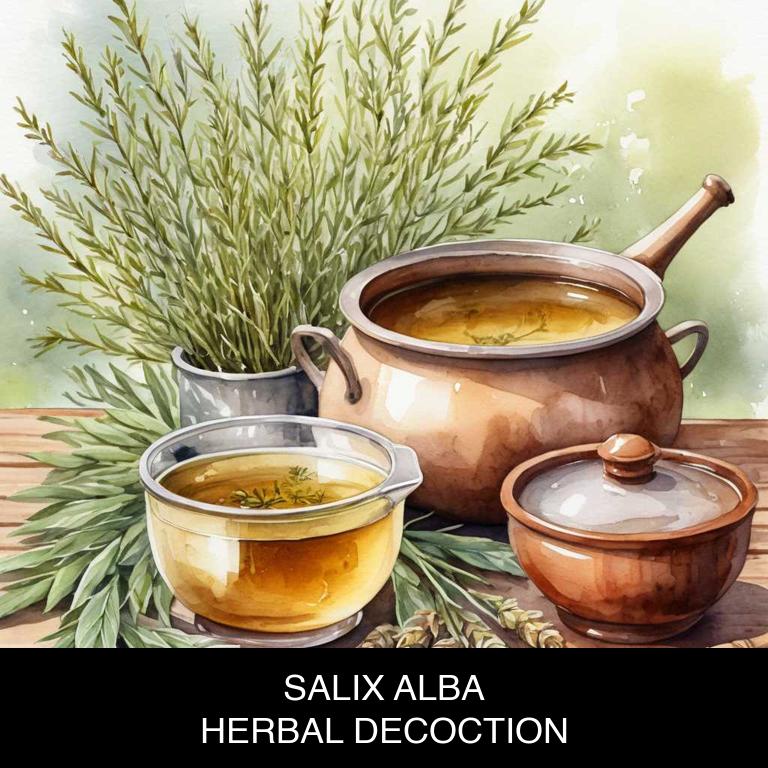
Medicinal Constituents
The list below shows the primary medicinal constituents in Salix alba decoctions that help with arthritis.
- Salicin: A glycoside that is converted into salicylic acid in the body, providing anti-inflammatory and pain-relieving effects, which can help reduce the symptoms of arthritis.
- Flavonoids: These phenolic compounds have potent anti-inflammatory and antioxidant properties, which can help reduce inflammation and oxidative stress associated with arthritis.
- Salicortin: A triterpenoid saponin that has anti-inflammatory and anti-arthritic effects, which may help reduce the symptoms of arthritis by inhibiting the production of pro-inflammatory cytokines and enzymes.
Parts Used
The list below shows the primary parts of white willow used to make decoctions for arthritis.
- Barks: Barks are the most used part due to their high concentration of salicin, a compound similar to aspirin, which helps reduce pain and inflammation.
- Leaves: Leaves are used due to their salicin content, which helps alleviate arthritis symptoms such as joint pain and swelling.
- Stems: Stems are used due to their rich source of salicin, which provides anti-inflammatory and analgesic effects to help manage arthritis symptoms.
Quick Recipe
The following recipe gives a procedure to make a basic white willow for arthritis.
- Harvest salix alba bark in the spring or fall to ensure optimal medicinal properties retention.
- Chop 50 grams of the harvested bark into small pieces for efficient infusion.
- Combine the chopped bark with 1 liter of boiling water to create a decoction.
- Boil the mixture for 10-20 minutes to release the active compounds from the bark.
- Strain the decoction through a cheesecloth or a fine-mesh sieve to remove the solids.
7. Hypericum perforatum
St John's wort decoctions helps with arthritis because of its anti-inflammatory and pain-relieving properties.
The decoction's bioactive compounds, such as hyperforin and hypericin, have been shown to inhibit the production of pro-inflammatory cytokines, reducing joint swelling and stiffness. Additionally, St John's wort has been found to increase the production of cortisol, a hormone that helps regulate inflammation, providing relief from arthritis symptoms like pain, redness, and warmth in the joints.
By promoting relaxation and reducing inflammation, St John's wort decoctions may offer a natural alternative for managing arthritis symptoms.

Medicinal Constituents
The list below shows the primary medicinal constituents in Hypericum perforatum decoctions that help with arthritis.
- Hyperforin: A phloroglucinol derivative that has anti-inflammatory properties, helping to reduce joint inflammation and pain associated with arthritis.
- Quercetin: A flavonoid that acts as a powerful antioxidant and anti-inflammatory agent, reducing oxidative stress and inflammation in joints and alleviating arthritis symptoms.
- N-feruloyltyramine: A phenolic compound with analgesic and anti-inflammatory properties, helping to reduce pain and inflammation in joints affected by arthritis.
Parts Used
The list below shows the primary parts of st john's wort used to make decoctions for arthritis.
- Leaves: Rich in hyperforin and hypericin, which have anti-inflammatory and analgesic properties.
- Flowers: Contain flavonoids and phenolic acids, which help reduce inflammation and pain associated with arthritis.
- Roots: Store a higher concentration of bioactive compounds like hyperforin and hypericin, making them useful for decoctions.
Quick Recipe
The following recipe gives a procedure to make a basic st john's wort for arthritis.
- Harvest 20-30 grams of fresh hypericum perforatum flowers or 10-20 grams of dried flowers.
- Chop the harvested flowers into small pieces to release their medicinal properties immediately.
- Combine 20-30 grams of chopped flowers with 1 liter of boiling water and let steep for 10-15 minutes.
- Strain the decoction through a cheesecloth or a fine-mesh sieve into a clean container.
- Store the decoction in a cool dark place and use within 24 hours for maximum potency.
8. Vaccinium macrocarpon
Highbush cranberry decoctions helps with arthritis because it is rich in anthocyanins, powerful antioxidants that combat inflammation and reduce oxidative stress.
The decoction's anti-inflammatory properties help alleviate joint pain and stiffness associated with arthritis, making movement easier and more comfortable. Additionally, highbush cranberry's flavonoids work synergistically to strengthen connective tissue, improving joint health and reducing the risk of further damage.
This natural remedy provides a gentle yet effective approach to managing arthritis symptoms.
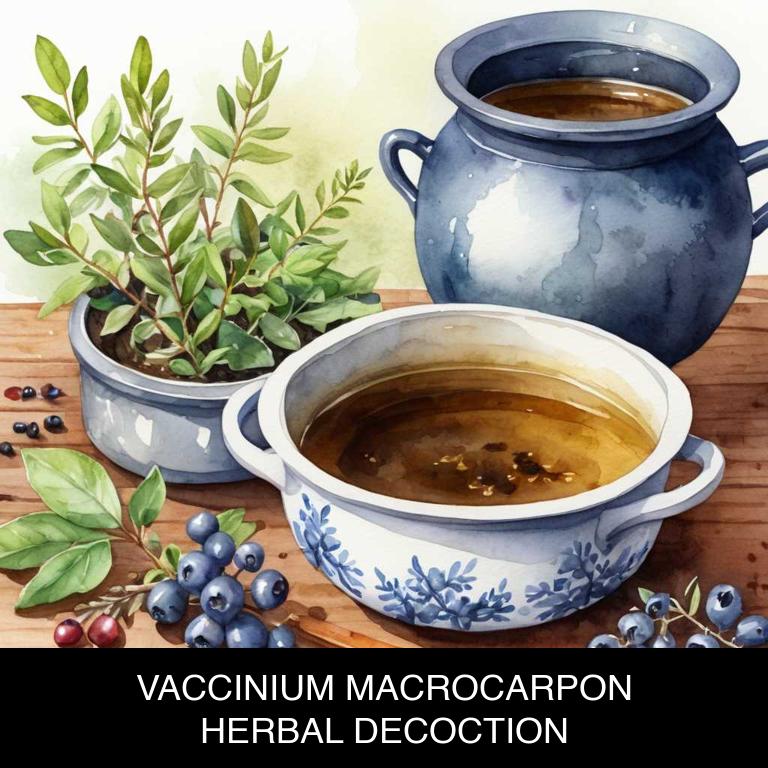
Medicinal Constituents
The list below shows the primary medicinal constituents in Vaccinium macrocarpon decoctions that help with arthritis.
- Anthocyanins: These powerful antioxidants help reduce inflammation and alleviate joint pain by inhibiting the production of pro-inflammatory enzymes and cytokines associated with arthritis.
- Flavonoids: Specifically, quercetin, a flavonoid found in Vaccinium macrocarpon, has potent anti-inflammatory and antioxidant properties that help reduce joint inflammation and pain by suppressing the activity of pro-inflammatory enzymes and cytokines.
- Tannins: Tannins in Vaccinium macrocarpon decoctions have anti-inflammatory and analgesic effects that help reduce joint pain and inflammation by inhibiting the production of pro-inflammatory cytokines and enzymes, and also by promoting the production of anti-inflammatory cytokines.
Parts Used
The list below shows the primary parts of highbush cranberry used to make decoctions for arthritis.
- Fruits: They are used due to their anti-inflammatory and antioxidant properties, which help alleviate arthritis symptoms.
- Leaves: They contain flavonoids and other compounds that contribute to their anti-inflammatory and analgesic effects, making them useful in arthritis treatment.
- Roots: They are used in decoctions for arthritis due to their reported anti-inflammatory and antioxidant properties, which may help reduce joint pain and inflammation.
Quick Recipe
The following recipe gives a procedure to make a basic highbush cranberry for arthritis.
- Gather 30 grams of dried vaccinium macrocarpon berries and store them in a clean airtight container.
- Combine the dried vaccinium macrocarpon berries with 1 liter of water in a saucepan and bring to a boil.
- Reduce the heat to a simmer for 5 minutes to allow the flavors to infuse.
- Strain the decoction through a cheesecloth or a fine-mesh sieve to remove the solids.
- Discard the solids and let the decoction cool to room temperature before storing it in a refrigerator.
9. Lavandula angustifolia
English lavender decoctions helps with arthritis because of its potent anti-inflammatory properties, which effectively reduce joint pain and swelling.
The decoction's flavonoids and terpenes work together to inhibit the production of pro-inflammatory enzymes, thereby alleviating inflammation and discomfort. Additionally, English lavender has been shown to have analgesic properties, providing relief from chronic joint pain.
By promoting relaxation and reducing anxiety, it also helps mitigate the psychological impact of arthritis, leading to improved overall well-being and quality of life.
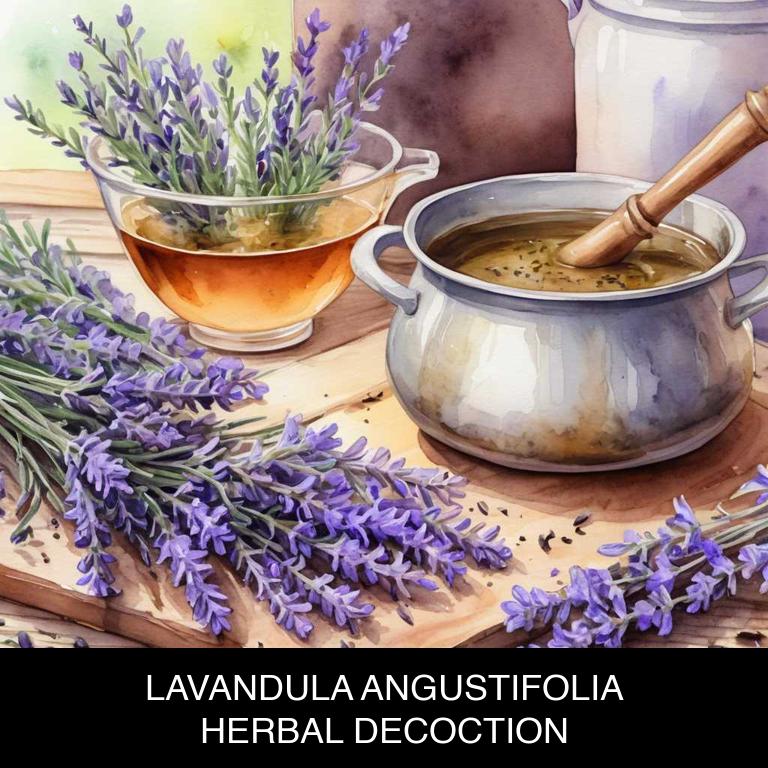
Medicinal Constituents
The list below shows the primary medicinal constituents in Lavandula angustifolia decoctions that help with arthritis.
- Linalool: This terpene has anti-inflammatory and analgesic properties, helping to reduce joint pain and inflammation associated with arthritis.
- Linalyl acetate: This terpene also has anti-inflammatory and analgesic effects, which may help to alleviate pain and swelling in arthritic joints.
- Caffeic acid: This phenolic compound has antioxidant and anti-inflammatory properties, which can help to reduce oxidative stress and inflammation in arthritic joints, promoting joint health and reducing pain.
Parts Used
The list below shows the primary parts of english lavender used to make decoctions for arthritis.
- Leaves: They are used due to their rich content of flavonoids and phenolic acids, which have anti-inflammatory properties that help alleviate arthritis symptoms.
- Flowers: They are used because they contain linalool and linalyl acetate, which have analgesic and anti-inflammatory effects that help relieve arthritis pain and inflammation.
- Stems: They are used due to their high content of sesquiterpenes, which have anti-inflammatory and antioxidant properties that help reduce arthritis symptoms and prevent further damage.
Quick Recipe
The following recipe gives a procedure to make a basic english lavender for arthritis.
- Gather 1 ounce of dried lavandula angustifolia flowers and store them in an airtight container for later use.
- Measure 1 teaspoon of the dried flowers and place them in a heat-resistant cup or bowl.
- Bring 8 ounces of water to a boil in a saucepan and pour it over the dried flowers.
- Steep the mixture for 5-7 minutes and then strain the liquid through a cheesecloth into a separate container.
- Discard the solids and let the decoction cool to room temperature before storing it in the refrigerator.
10. Rosa rugosa
Beach rose decoctions helps with arthritis because they contain potent anti-inflammatory compounds that reduce joint pain and swelling.
The decoction's antioxidants also help to repair damaged cartilage, promoting healthy joints. Additionally, beach rose has been shown to inhibit the production of pro-inflammatory enzymes, which can contribute to chronic inflammation in the body.
As a result, regular consumption of beach rose decoctions may provide relief from arthritis symptoms, improving overall joint mobility and comfort.

Medicinal Constituents
The list below shows the primary medicinal constituents in Rosa rugosa decoctions that help with arthritis.
- Flavonoids: These compounds, particularly quercetin, help alleviate arthritis symptoms by reducing inflammation and suppressing the production of pro-inflammatory enzymes.
- Triterpenoids and phenolic acids: These constituents, such as ursolic acid and rosmarinic acid, possess potent anti-inflammatory and antioxidant properties, which help reduce joint pain and inflammation associated with arthritis.
- Polysaccharides: The polysaccharides present in Rosa rugosa decoctions, such as pectin and raffinose, have been shown to have immunomodulatory effects, which may help regulate the immune response and alleviate arthritis symptoms.
Parts Used
The list below shows the primary parts of beach rose used to make decoctions for arthritis.
- Roots: They contain a compound called salicylic acid, which has anti-inflammatory properties that can help alleviate arthritis symptoms.
- Leaves: They are rich in flavonoids and phenolic acids, which have antioxidant and anti-inflammatory effects that can help reduce joint pain and inflammation.
- Buds: They contain a compound called spiraeoside, which has anti-inflammatory properties that can help reduce inflammation and pain associated with arthritis.
Quick Recipe
The following recipe gives a procedure to make a basic beach rose for arthritis.
- Harvest 20-30 rosa rugosa flowers and 15-20 stems in the morning for optimal potency and quality.
- Dry the collected flowers and stems in a single layer at 40°c for 2-3 hours using a food dehydrator.
- Weigh 20 grams of dried rosa rugosa flowers and 10 grams of dried stems for the decoction.
- Combine the weighed dried rosa rugosa flowers and stems with 500 milliliters of water in a saucepan.
- Boil the mixture for 10-15 minutes then reduce heat and simmer for another 20-25 minutes to extract the active compounds.
What is the best combination of herbal decoctions to use for arthritis?
The best combination of herbal decoctions that help with arthritis is a blend of turmeric, ginger, and willow bark.
Turmeric contains curcumin, a powerful anti-inflammatory compound that reduces joint pain and inflammation. Ginger has analgesic and anti-inflammatory properties that aid in reducing pain and swelling.
Willow bark contains salicin, a natural pain reliever similar to aspirin. Combining these herbs in a decoction can provide relief from arthritis symptoms and promote overall joint health.
This natural remedy can be consumed 2-3 times a day to alleviate symptoms.
What ailments similar to arthritis are treated with herbal decoctions?
Ailments similar to arthritis/decoctions.html">arthritis/decoctions.html">arthritis that are treated with herbal decoctions are fibromyalgia, tendinitis, and gout.
Decoctions made from herbs such as turmeric, ginger, and willow bark can help reduce inflammation and alleviate symptoms of these conditions.
Other herbs like devil's claw and ashwagandha may also be used to relieve joint pain and stiffness.